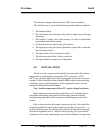
Part III: 1-13
Oil in Water Part III
Teledyne Analytical Instruments
manually calibrating the analyzer system.
Oil in Water Piping Diagram (simplest)
Homogenizing
Input flowrate to the sample homogenizer module inlet is precisely and
accurately controlled by a mechanical flow controller designed for continuous
duty. Because of the style, construction, and position in the sample system, the
controller solves many of the problems associated with sample handling at the
flowrates dictated by the preconditioning technique. For sample concentration
over 20 ppm total oil homogenization is always required-regardless of the
analyzer used to measure the oil above 20 ppm, most waters are so enriched that
oils do not remain homogenized nor miscible enough to measure accurately.
3.4.2 Zero Water Preconditioning System
Since the analyzer operates at a fixed measuring wavelength, and many
soluble organic compounds absorb to some degree at this wavelength, the
effects of organics other than oil must be eliminated from the analysis. Thus, a
solution is prepared that is essentially free of oil, but retains all the other organic
characteristics of the unconditioned sample. When presented to the analyzer, the
absorption caused by the unknown organic compounds in this oil-free water can
be nullified by eliminating any electronic signal that is generated while the
solution is undergoing analysis.
The nondissolved oil is removed by coarse filtering, and the dissolved oil
removed by fine filtering, the water contains only the non-oil organic fraction of
the effluent stream; i.e., it can be used as a reference or “zero oil” water. During
the zero cycle, all solenoid valves are energized and the zero water is pumped
through SV3 to the sample cell. Since turbidity is ratioed out by the electro-
V5
V6
V7


















